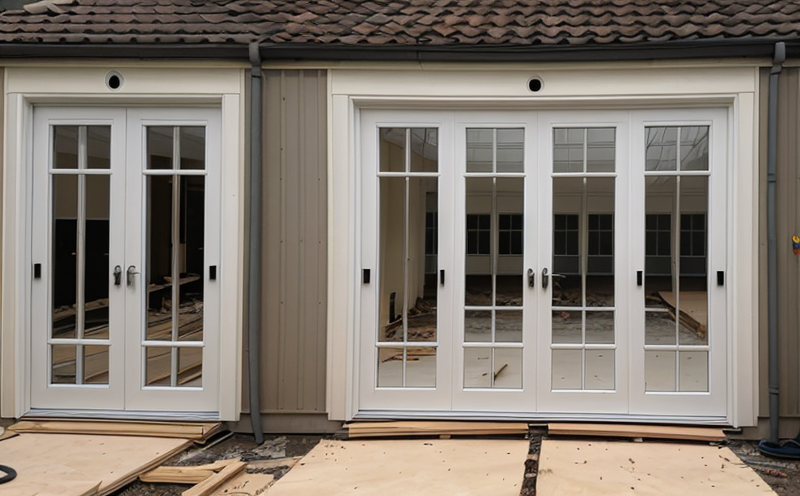Heat Transfer Assessment through Fire Doors
In the realm of fire safety testing, heat transfer assessment through fire doors plays a critical role in ensuring compliance with building regulations and international standards. Heat transfer is one of the key factors that determine the performance of fire doors, especially during intense fires where the integrity of these doors can mean the difference between life and death.
Fire doors are designed to resist the passage of heat, smoke, and flames for a specified period in case of a fire. The objective of this testing is to evaluate how effectively the door maintains its integrity under high-temperature conditions. This service assesses the thermal performance of fire doors by measuring their ability to withstand heat transfer from one side of the door to the other.
The process involves subjecting the fire door to controlled heating, typically using a standard furnace or calorimeter, and then monitoring the temperature increase on the cooler side. The aim is not only to ensure that the door meets the required thermal resistance but also to understand its behavior under extreme conditions. This assessment helps in identifying any potential vulnerabilities which could lead to heat transfer and compromise fire safety.
Compliance with relevant standards such as BS 973-1:2014 (Fire doors – Part 1: Requirements) is crucial for this service. These standards define the criteria that a fire door must meet, including its ability to resist heat transfer and maintain structural integrity.
For R&D engineers and quality managers, understanding the exact parameters involved in the testing process is paramount. This includes knowing the specific conditions under which the tests are conducted, such as the type of furnace used, the duration of exposure, and the precise temperature ranges applied. Compliance officers also benefit from this detailed insight to ensure that their facilities adhere strictly to all regulations.
During specimen preparation for heat transfer assessment, it is essential to follow stringent procedures to ensure accuracy and reliability. The fire door must be placed in a controlled environment where its thermal properties can be accurately measured. This often involves the use of specialized equipment such as calorimeters or furnace simulators that provide precise temperature control.
The testing process itself requires meticulous attention to detail, from setting up the test apparatus correctly to ensuring accurate measurement of temperatures before and after exposure. The data collected during these tests is then analyzed using sophisticated software tools that can provide a comprehensive report on the performance of the fire door.
Scope and Methodology
| Key Components | Description |
|---|---|
| Furnace or Calorimeter Setup | The equipment used to apply controlled heat to the fire door. |
| Temperature Monitoring Sensors | Devices placed on both sides of the door to measure temperature changes accurately. |
| Specimen Preparation | The process of setting up the fire door for testing, including cleaning and positioning. |
| Data Collection and Analysis | The methodologies used to gather data and interpret it against set standards. |
Benefits
The benefits of heat transfer assessment through fire doors extend beyond mere compliance with regulations. By conducting this test, organizations can significantly enhance the safety and security of their buildings. For instance, knowing exactly how a fire door performs under extreme conditions allows for proactive maintenance measures to be implemented.
Moreover, such assessments provide valuable insights into potential weaknesses in the design or materials used, enabling engineers to make informed decisions about improvements. This not only contributes to better overall building safety but also supports continuous improvement initiatives within organizations.
In terms of compliance, passing these rigorous tests can be a significant advantage when seeking certification for new buildings or renovations. It demonstrates a commitment to high standards and adds credibility to the organization's reputation in the market.
From an R&D perspective, this service offers unique opportunities for innovation. By pushing the boundaries of current knowledge on heat transfer through fire doors, engineers can develop more effective materials and designs that surpass existing standards.
Quality and Reliability Assurance
- Use of ISO/IEC 17025 accredited laboratories for testing.
- Adherence to international standards such as BS 973-1:2014.
- Detailed documentation and reporting of all test procedures and results.
- Regular calibration of all equipment used in the testing process.





